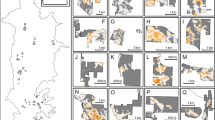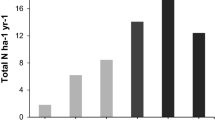Abstract
Understanding the causes and consequences of component change in sagebrush steppe is crucial for evaluating ecosystem sustainability. The sagebrush (Artemisia spp.) steppe ecosystem of the northwest USA has been impacted by the invasion of exotic grasses, increasing fire return intervals, changing land management practices, and fragmentation, often lowering the overall resilience to change. We utilized contemporary and historical Landsat imagery, field data, and regression tree models to produce fractional cover maps of rangeland components (shrub, sagebrush, herbaceous, bare ground, and litter) through the last 30 years. Our main goals were to (1) investigate rangeland component trends over 30 years, (2) evaluate the magnitude and direction of trends in components and climate drivers and their relationship, and (3) assess component trends influenced by climate. Results indicated that over the study period, shrub, sage, herbaceous, and litter cover decreased, while bare ground cover increased. Measured rates of change ranged from − 0.14% decade−1 for shrub cover to 0.05% decade−1 for bare ground, whereas herbaceous and litter cover trends were negligible. Net landscape cover changes were consistent with expectations of climate change and disturbance producing a loss of biotic cover, and converting a portion of shrub and sagebrush to herbaceous cover. Overall, fire and related successional recovery was the greatest change agent for all components in terms of area and cover change, while increasing minimum temperature, at a rate of 0.66°C decade−1, was found to be the most significant climate driver.







Similar content being viewed by others
References
Beschta RL, Donahue DL, Dellasala DA, Rhodes JJ, Karr JR, O’Brien MH, Fleischner TL, Deacon Williams C. 2013. Adapting to climate change on western public lands: addressing the ecological effects of domestic, wild, and feral ungulates. Environ Manag 51:474–91.
BLM. 2016. Map and data. BLM. Accessed September 1, at https://www.blm.gov/or/gis/data-details.php?id=421.
Brabec MA. 2014. Big sagebrush (Artemisia tridentata) in a shifting climate context: assessment of seedling responses to climate. Boise (ID): Boise State University. p 131.
Bradley BA. 2010. Assessing ecosystem threats from global and regional change: hierarchical modeling of risk to sagebrush ecosystems from climate change, land use and invasive species in Nevada, USA. Ecography 33:198–208.
Bradley BA, Curtis CA, Chambers JC. 2016. Bromus response to climate and projected changes with climate change. In: Germino MJ, Chambers JC, Brown CS, Eds. Exotic brome-grasses in arid and semiarid ecosystems of the western US causes, consequences, and management implications. Berlin: Springer. p 257–74.
Brown JH, Valone TJ, Curtin CG. 1997. Reorganization of an arid ecosystem in response to recent climate change. Proc Natl Acad Sci U S A 94:9729–33.
Chambers JC, Pellant M. 2008. Climate change impacts on Northwestern and intermountain United States rangelands. Rangelands 30:29–33.
Davies KW, Vavra M, Schultz B, Rimbey N. 2014. Implications of longer term rest from grazing in the sagebrush steppe. J Rangel Appl 1:14–34.
Easterling DR, Horton B, Jones PD, Peterson TC, Karl TR, Parker DE, Salinger MJ, Razuvayev V, Plummer N, Jamason P, Folland CK. 1997. Maximum and minimum temperature trends for the globe. Science 277:364–7.
Eldridge DJ, Poore AGB, Ruiz-Colmenero M, Letnic M, Soliveres S. 2016. Ecosystem structure, function, and composition in rangelands are negatively affected by livestock grazing. Ecol Appl 26:1273–83.
GeoMAC Wildland Fire Support. 2016. Geospatial multi-agency coordination, services and data. U.S. Geological Survey. Accessed September 1, 2016, at https://www.geomac.gov/index.shtml.
Hicke JA, Asner GP, Randerson JT, Tucker C, Los S, Birdsey R, Jenkins JC, Field C. 2002. Trends in North American net primary productivity derived from satellite observations, 1982–1998. Glob Biogeochem Cycles 16. doi:10.1029/2001GB001550.
Homer C, Dewitz J, Yang L, Jin S, Danielson P, Xian G, Coulston J, Herold N, Wickham J, Megown K. 2015a. Completion of the 2011 national land cover database for the conterminous United States—representing a decade of land cover change information. Photogramm Eng Remote Sens 81:346–54.
Homer CG, Xian G, Aldridge CL, Meyer DK, Loveland TR, O’Donnell MS. 2015b. Forecasting sagebrush ecosystem components and greater sage-grouse habitat for 2050: learning from past climate patterns and Landsat imagery to predict the future. Ecol Indic 55:131–45.
Liu Y, Li Y, Li S, Motesharrei S. 2015. Spatial and temporal patterns of global NDVI trends: correlations with climate and human factors. Remote Sens 7:13233–50.
Manier DJ, Hobbs NT. 2006. Large herbivores influence the composition and diversity of shrub-steppe communities in the Rocky Mountains, USA. Oecologia 146:641–51.
Menne MJ, Williams CN, Vose RS, Jr. 2017. United states historical climatology network. Accessed March 7, at http://cdiac.ornl.gov/epubs/ndp/ushcn/ushcn_map_interface.html.
Miller RF, Knick ST, Pyke DA, Meinke CW, Hanser SE, Wisdom MJ, Hild AL. 2011. Characteristics of sagebrush habitats and limitations to long-term conservation. In: Knick ST, Connelly JW, Eds. Greater sage-grouse: ecology and conservation of a landscape species and its habitats. Berkeley (CA): University of California Press. p 145–84.
MTBS. 2016. Data access. LANDFIRE. Accessed September 1, 2016, at http://www.mtbs.gov/dataaccess.html.
Neilson RP, Lenihan JM, Bachelet D, Drapek RJ. 2005. Climate change implications for sagebrush ecosystem. Transactions North American wildlife and natural resources conference, pp 145–159.
NLCD. 2011. NLCD 2001 to 2011 land cover from to change index. Multi-Resolution Land Characteristics Consortium (MRLC). Accessed March 1, 2015, at https://www.mrlc.gov/nlcd11_data.php.
Norton J, Glenn N, Germino M, Weber K, Seefeldt S. 2009. Relative suitability of indices derived from Landsat ETM + and SPOT 5 for detecting fire severity in sagebrush steppe. Int J Appl Earth Obs Geoinf 11:360–7.
Omernik JM. 1987. Ecoregions of the conterminous United States. Ann Assoc Am Geogr 77:118–25.
Polley HW, Briske DD, Morgan JA, Wolter K, Bailey DW, Brown JR. 2013. Climate change and North American rangelands: trends, projections, and implications. Rangel Ecol Manag 66:493–511.
Rehfeldt GE, Crookston NL, Sáenz-Romero C, Campbell EM. 2012. North American vegetation model for land-use planning in a changing climate: a solution to large classification problems. Ecol Appl 22:119–41.
Rigge M, Wylie B, Gu Y, Belnap J, Phuyal K, Tieszen L. 2013. Monitoring the status of forests and rangelands in the Western United States using ecosystem performance anomalies. Int J Remote Sens 34:4049–68.
Sant ED, Simonds GE, Ramsey RD, Larsen RT. 2014. Assessment of sagebrush cover using remote sensing at multiple spatial and temporal scales. Ecol Indic 43:297–305.
Sims PL, Singh JS. 1978. The structure and function of ten western North American grasslands: III. Net primary production, turnover and efficiencies of energy capture and water use. J Ecol 66:573–97.
Still SM, Richardson BA. 2015. Projections of contemporary and future climate niche for wyoming big sagebrush (Artemisia tridentata subsp. wyomingensis): a guide for restoration. Nat Areas J 35:30–43.
Svejcar T, Boyd C, Davies K, Madsen M, Bates J, Sheley R, Marlow C, Bohnert D, Borman M, Mata-Gonzàlez R, Buckhouse J, Stringham T, Perryman B, Swanson S, Tate K, George M, Ruyle G, Roundy B, Call C, Jensen K, Launchbaugh K, Gearhart A, Vermeire L, Tanaka J, Derner J, Frasier G, Havstad K. 2014. Western land managers will need all available tools for adapting to climate change, including grazing: a critique of Beschta and others. Environ Manag 53:1035–8.
Thornton PE, Thornton MM, Mayer BW, Wei Y, Devarakonda R, Vose RS, Cook RB. 2016. Daymet: Daily surface weather data on a 1-km grid for North America, Version 3. at https://doi.org/10.3334/ORNLDAAC/1328.
U.S. Fish and Wildlife Service. 2017. National wetlands inventory. Accessed July 14, at https://www.fws.gov/wetlands/.
USFS. 2016. FSGeodata clearinghouse. USDA forest service. Accessed May 1, at https://data.fs.usda.gov/geodata/.
Veblen KE, Pyke DA, Aldridge CL, Casazza ML, Assal TJ, Farinha MA. 2014. Monitoring of livestock grazing effects on bureau of land management land. Rangel Ecol Manag 67:68–77.
Vogelmann JE, Gallant AL, Shi H, Zhu Z. 2016. Perspectives on monitoring gradual change across the continuity of Landsat sensors using time-series data. Remote Sens Environ 185:258–70.
Vogelmann JE, Xian G, Homer C, Tolk B. 2012. Monitoring gradual ecosystem change using Landsat time series analyses: case studies in selected forest and rangeland ecosystems. Remote Sens Environ 122:92–105.
Xian G, Homer C, Aldridge C. 2012. Effects of land cover and regional climate variations on long-term spatiotemporal changes in sagebrush ecosystems. GISci Remote Sens 49:378–96.
Xian G, Homer C, Rigge M, Shi H, Meyer D. 2015. Characterization of shrubland ecosystem components as continuous fields in the northwest United States. Remote Sens Environ 168:286–300.
Acknowledgements
The authors would like to thank the editors and the anonymous reviewers, special thanks to the subject-matter editor Dr. Jeffrey Hicke who had many helpful comments for revising the manuscript. We also thank Dr. James Vogelmann, Dr. Bruce Wylie and Mr. Roger Auch for their reviews and suggestions to improve the manuscript. Hua Shi and Matthew Rigge’s work was performed under USGS contract G13PC00028. Debbie Meyer and Brett Bunde’s work was performed under USGS contract G15PC00012.
Author information
Authors and Affiliations
Corresponding author
Additional information
The NLCD shrub data associate with this manuscript is posted at: https://www.mrlc.gov/nlcdshrub.php.
Electronic supplementary material
Below is the link to the electronic supplementary material.
Rights and permissions
About this article
Cite this article
Shi, H., Rigge, M., Homer, C.G. et al. Historical Cover Trends in a Sagebrush Steppe Ecosystem from 1985 to 2013: Links with Climate, Disturbance, and Management. Ecosystems 21, 913–929 (2018). https://doi.org/10.1007/s10021-017-0191-3
Received:
Accepted:
Published:
Issue Date:
DOI: https://doi.org/10.1007/s10021-017-0191-3




